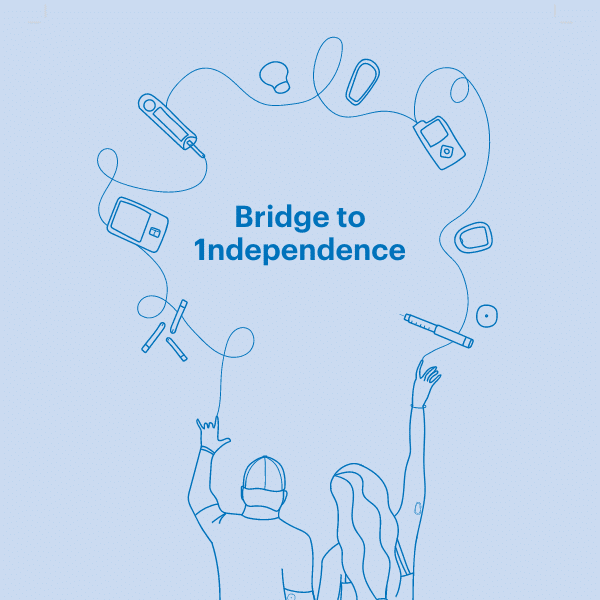Moving from paediatric to adult diabetes services
Here's what you need to know about making the step to adult diabetes care.

Are you a young person between 12 and 18 who currently sees a paediatric diabetes care team? This page is for you! (And your parents/carers, too). You’ll find lots of useful information, resources and tips to prepare you for changes to your type 1 diabetes (T1D) care as you get older.
What is transition?
When it comes to T1D, transition is when you move from a paediatric diabetes service to an adult service. This can happen anywhere from 16 to 18 years of age. You’ll probably be starting to outgrow the services provided by your paediatric team, which means it’s time to move to an adult team for your future T1D care and management.
Transition is usually planned well in advance of the changeover, giving you and your parents/carers time to understand the changes and what they mean for you all. It gives you time to learn what to expect, who the new team will be, and what skills you may need to learn before you make the move. This lets you start thinking about being more independent and responsible for your own healthcare.
It’s not as daunting as it may sound, and you’ll be helped every step of the way by your current health team and your parents/carers.
Stages of transition
Your care team will give you information to help support you at each stage of the transition process. This will all help make sure you’re ready when the time comes.
These are the typical stages of the transition process, but they’re only a guide. They depend on your own personal development and the process your diabetes team has in place.

Introduction/planning
12-14 years
Working out what you need to know

Preparation
14-16 years
Starting to learn to look after yourself

Transfer
16-18 years
Looking after yourself with confidence
What does adult care look like? You could attend...
A transition clinic (young adult clinic)
This clinic is specifically designed for people aged 16 to 24 years old. These clinics are generally run in the public hospital system and are covered by Medicare.
An adult clinic
Adult clinics look after adult diabetes patients of all ages, and cover all types of diabetes. They’re run out of public hospitals and are covered by Medicare.
Healthcare professionals in private practice
You might see endocrinologists, diabetes educators, optometrists, dieticians, and psychologists in a private practice setting. You’ll have to pay fee – this varies, and could be covered fully or partially by Medicare, or subsidised through private health insurance.
TIP: It’s always best to find out the cost of a consultation before making an appointment.

Questions to ask
Your diabetes team will let you know which adult services are near you. Ask lots of questions, like:
- How often should I go?
- Do I see the same doctors for each appointment?
- Can I schedule appointments to fit in with my work/study?
- Which clinicians will I see at the clinic, and which will I need to organise separately?
- Do they check my HbA1c or do I need to organise it before my appointment?
- Do I need a referral letter from my doctor?
- Is there a cost or is it covered by Medicare?
The practical stuff
Getting your own Medicare card
A Medicare card lets you get free or cheaper health care, as well as cheaper medicine. You can use a Medicare card with doctors who bulk bill for their services and at clinic appointments in a public hospitals. There are benefits to getting your own card.
Your name will be on your parents’ or carers’ Medicare cards until you’re 15. After that, you can apply for your own card (here’s how).
You can also choose to stay on your family’s account until you’re ready – in that case, your parents or carers can apply for an extra card you can use.
No matter which option you choose, having an extra family card or your own Medicare card makes it more convenient when you go to clinic appointments on your own. It’s also handy if you’re heading away on a trip or living away from home.
TIP: Once you get your card, add a digital copy to your phone. It’s one thing less to think about before your appointments!
Dealing with your prescriptions and diabetes supplies
As you become more independent, you might want to start thinking about what you need to treat and manage your T1D, including your prescription items and consumables.
Get some pointers to help you get ahead.

Driving with T1D
Ready to get your licence – your Ls, Ps or full licence? The good news is: you can! As always, having T1D shouldn’t stop you from living your best life – there are just a few things that need to be considered before you get behind the wheel.
See our checklist of what you need to do and our guide to driving with T1D.
Looking after you
Be kind to yourself
There will be days that T1D sucks. You could be tired, your BGLs aren’t playing nice, and generally navigating young adulthood tends to be hard. It’s important to be kind to yourself. Talk to yourself as if you were cheering up a friend. Tomorrow is a brand new day!
Remember that perfection is impossible
It’s very hard to manage T1D, and it’s just not possible to be perfect all the time. If you’re having a tough day, remember that you’re doing your best. But if you’re having more tough days than not, it might be time to reach out to your diabetes team and see if they can help you tweak your T1D management. It’s aways important to stay safe.
Type 1 takes 2 (or 3, or 4...)
You’re never alone in this. T1D can take its toll, but you don’t need to manage it all on your own. Create your support network – it may be your boyfriend or girlfriend, your bestie, your housemate or your parents. Educate them so they understand how they can support you (without crossing any boundaries and making you more stressed!). Reach out to online support groups – they’re the people who really understand what you’re dealing with.
Use apps to help support your mental wellbeing
CALM: Listen to calming sounds and videos to manage stress and anxiety, get better sleep, and feel more present in your life. Cost: Free trial then $6.67 a month
MINDMISSION: Helps you learn new and better ways of coping with low moods and anxiety. Cost: Free. Only available on iOs
MINDSHIFT CBT: Uses cognitive behavioural therapy exercises to change your relationship with anxiety and develop more effective ways of thinking. Cost: Free
RISE UP & RECOVER: For those struggling with food and body image, including people recovering from disordered eating. Cost: Free
SMILING MIND: A mindfulness program with age-specific modules, encouraging you to maintain your mental health in fun and interactive ways. Cost: Free
Live your life!
Remember that T1D doesn’t define you – it’s only one part of your life. Make sure you look after yourself, have good people around you and enjoy this exciting time as you step into adulthood.
You’ve done an amazing job supporting your child and helping them manage their T1D. And now they’re starting to move into adult care, which will mean a new stage for you… but your job isn’t done yet! Here’s some advice to help you both navigate the next chapter.
➜ Each diabetes service is different, so initiate a discussion with your child’s diabetes team. Ask them what their transition process is, when it will start, and how you can help prepare your child.
➜ Be mindful that the transition process and actual changeover from paediatric to adult care can occur anywhere between the ages of 12-18, based on your child’s personal development and when their diabetes team thinks they’re ready. This decision should be made in consultation with you and your child.
➜ Talk to your child about what transition is and why it happens. Think about how it helps prepare them to independently manage their diabetes as they move towards adulthood and all that means – finishing school, getting a job, moving out, and travelling.
➜ Once you know the timeline for their transition, start working with your child so they can:
-
- learn to carb count on their own, and manage some (or all) of their diabetes management
- take initiative to make their next appointment, and have them save the appointment on their own phone (with alerts set up to remind them – they might want to set them for 2 weeks before, 1 week before, and the day before the appointment)
- talk directly to their care team, and ask their own questions.
➜ Remember to take small steps, making sure your child understands it’s all part of preparing them for actual transition. Talk to their diabetes team throughout the process – they’ll provide you both with support, practical checklists, and help prepare your child.
